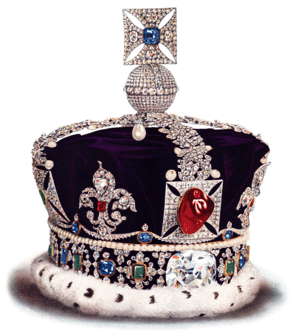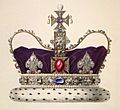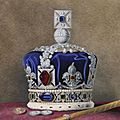Imperial State Crown facts for kids
Quick facts for kids Imperial State Crown |
|
|---|---|
 |
|
| Details | |
| Country | United Kingdom |
| Made | 1937 (current version) |
| Owner | Queen Elizabeth II in right of the Crown |
| Weight | 1.06 kg (2.3 lb) |
| Arches | Two |
| Material | Gold, silver, platinum |
| Cap | Velvet trimmed with ermine |
| Notable stones | Cullinan II, St Edward's Sapphire, Black Prince's Ruby, Stuart Sapphire |
The Imperial State Crown is a very important crown in the United Kingdom. It is one of the Crown Jewels of the United Kingdom. This crown shows the power and independence of the monarch, who is the king or queen.
There have been different versions of this crown since the 1400s. The crown we see today was made in 1937. It looks a bit like St. Edward's Crown, but it's shorter and covered in many jewels.
The crown has a base with four crosses and four fleurs-de-lis. Above these are four half-arches that meet at a cross on top. Inside, there's a purple velvet cap with a soft ermine (a type of fur) trim.
This amazing crown holds many precious gems. It has 2,868 diamonds, 273 pearls, 17 sapphires, 11 emeralds, and 5 rubies.
Some of the jewels are very famous. The cross at the very top has the St. Edward's Sapphire. This sapphire is believed to have come from the ring of an old king, Edward the Confessor. On the front cross, you can see the Black Prince's Ruby. It's actually a type of gem called a spinel. Also on the front is the famous Cullinan II. This is also known as the Lesser Star of Africa. At the back of the crown, there's the 104-carat (20.8 g) Stuart Sapphire. The crown also has pearls that belonged to Queen Elizabeth.
Contents
What the Imperial State Crown Looks Like
The Imperial State Crown is about 31.5 cm (12.4 in) tall. It weighs about 1.06 kg (2.3 lb), which is like a small bag of sugar. It has four fleurs-de-lis and four crosses pattée. These support two arches that meet at a small globe, called a monde, topped with another cross.
The inside cap of the crown is made of purple velvet. It has a trim of ermine fur. The main frame of the crown is made from gold, silver, and platinum. It shines with all its jewels.
As mentioned, it has 2,868 diamonds, 273 pearls, 17 sapphires, 11 emeralds, and 5 rubies. Each one adds to its sparkle.
Famous Jewels in the Crown
The St Edward's Sapphire is on the cross at the very top. People say it came from the ring of Edward the Confessor. He was re-buried at Westminster Abbey in 1163.
The Black Prince's Ruby is on the front cross. It is a large red spinel. In 1909, the 104-carat (20.8 g) Stuart Sapphire was moved. It used to be at the front but was moved to the back. The huge 317-carat (63.4 g) Cullinan II took its place at the front.
Below the globe (monde) on the crown, there are four pearls. Three of these pearls are often said to have belonged to Queen Elizabeth I. However, this story is probably not true.
When the Crown is Used
The monarch wears the Imperial State Crown at the end of their coronation ceremony. This happens when they leave Westminster Abbey.
It is also worn or carried during the yearly State Opening of Parliament. This is a special event where the monarch gives a speech. Sometimes, like in 1974 and 2017, Queen Elizabeth II chose to wear a hat instead. This happened when there were quick elections.
Usually, the crown travels to the Palace of Westminster in its own carriage. It has armed guards to protect it. The crown is placed in a special room called the Robing Room. Here, the Queen puts on her robes and the crown before speaking to Parliament.
When the Imperial State Crown is not being used, you can see it. It is on public display in the Jewel House at the Tower of London.
Images for kids
-
The front of George I's State Crown, made in 1714.
-
Queen Victoria's crown, made in 1838.
-
George V wearing the crown in 1911.
-
Elizabeth II after her coronation in 1953.
See also
 In Spanish: Corona imperial del Estado para niños
In Spanish: Corona imperial del Estado para niños






